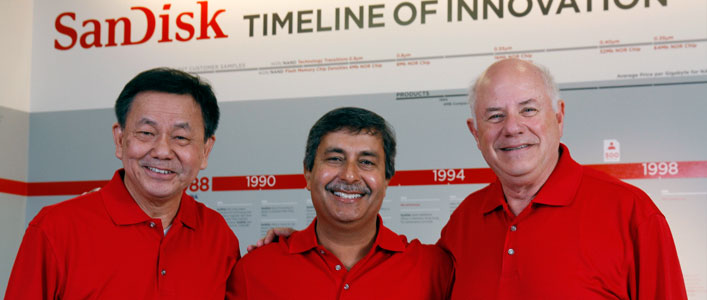Sandisk: The brand that pushes the limits in data storage
Data storage tools are developing rapidly with advancing technology. These vehicles, which started to enter our lives with discs and CDs in the 1990s, became smaller, cheaper and more useful with Sandisk products.

The Birth of the Sandisk Brand
The birth of the Sandisk brand dates back to 1988. Eli Harari, who works for a small electronics company in California, wanted to develop a new data storage unit that could replace HDDs in portable electronics. Until then, the technologies used to store electronic data were both very expensive and ineffective. Harari set out to enable much more data storage with smaller and more functional tools.
Eli Harari (1945- )
These studies, which he called System Flash, began to bear fruit towards the end of the 1980s. And together with his close friends Jack Yuan and Sanjay Mehrotra, he founded his company under the name Sundisk. The company was named that way by Harari's daughter to evoke "cheerful and sunny". Focusing on data storage tools, the company developed new and practical solutions in this field in the 1990s. It also played a very important role in the formation of basic standards with the collaborations it established.
In 1990, the company focused its efforts on flash memory for use in rapidly developing technological products such as notebook computers and digital cameras. Their first product, based on a 4 MB flash chip, marked a major milestone for flash memory. The world's first flash-based SSD, which they developed as an alternative to HDD, reached a capacity of 20 MB. They sent this product to IBM for review. When the demand for the product increased rapidly with the support of IBM, they opened their first foreign sales office in Japan in 1992.
The Rise of the Sandisk Brand
1993 was a very important turning point in the history of the company. As a matter of fact, the launch of a space shuttle in the USA with a Sundisk flash drive called Rainbow had a great impact around the world. Thanks to this launch, Sundisk has proven the robustness of its data storage products to the whole world. Interest in Sundisk products in the European market increased rapidly after this event and the company started to open new sales offices in Europe.
In this period, different technologies were adopted for data storage in digital products, and data transfer was very difficult as there was no standardization on card slots yet. In order to standardize card slots and facilitate data transfer in technological products, the company started contacting companies such as Canon and Kodak to develop a new ecosystem. As a result of these studies, they developed a new technology based on magnetic disk drive. They also achieved a significant reduction in drive costs and were able to reduce the cost of a 1GB flash memory to $1.
In the 1990s, the first flash memory-based movie cards, PCMCIAs, revolutionized data storage. The Sandisk 4 MB compact flash memory card, which was introduced to the market in 1994, made data storage both easy and economical. It also had a high performance. As the memory capacity of these products, which offer the opportunity to store digital film in a very small, cheap and fast way in digital cameras, the interest also increased. So much so that the number of compact flash memory cards introduced to the market in 3 years has exceeded 1 million.
In 1995, the company changed its name to Sandisk and went public. As a result of the worldwide fame and commercial success of compact flash memory cards, more than 16 million shares changed hands on the first day of their trading on the stock market. A year later, they introduced the world's first 64MB MLC NOR flash chip. In 1999, they made the first NAND joint investment with Toshiba to develop advanced technology and produce in high volume in the flash memory industry.
Sandisk in the World Market
Towards the end of the 1990s, Sandisk rose to a very important position in the world market. Its long-term cooperation with Toshiba has made significant contributions to the development of data storage products. As a matter of fact, as a result of this cooperation, flash memories of higher quality and much higher capacity were developed. In 2001, again with Toshiba, it launched the world's first commercial NAND MLC 1 GB chip, which offers the lowest cost per bit. Then, 128 MB SD cards, memory stick cards and 1 GB compact flash cards took their place in the market.
In 2002, the company shifted all NAND flash wafer production to Toshiba's factories in Japan and Yokkaichi. The first USB drives called Cruzer were also released on this date. Again, interest in mini SD removable cards developed for mobile phones on this date increased gradually with the spread of smartphones. The ABL technology it developed to improve memory performance and increase its security, on the other hand, led to the formation of standards in NAND flash technology. A year later, it further developed its work on high-performance industrial-grade SD cards, with total revenue reaching $1 billion.
Having achieved great success with the cooperation established with Toshiba, Sandisk entered into a cooperation with Motorola in 2004. With this collaboration, they launched the transflash removable memory card for mobile phones. This product was later called “micro SD”. The 128 MB micro SD memory cards and Sansa MP3 players released on the same date raised the brand recognition. In 2005, the company acquired Matrix Semiconductor, a pioneer and supplier of 3D-based programmable once-chip technology, cementing its strength in the world market.
Sandisk today
The growth process of Sandisk continued with an increasing momentum in the 2000s. In 2005, the company turned to data storage technologies in mobile devices and introduced 1 GB micro SD memory cards. A year later, he bought M-Systems, the inventor of USB sticks. It opened new production and assembly plants in different geographies of the world, especially in China. The 32 GB SATA 5000 SSD, introduced in 2008, pushed the limits in data storage and increased performance and reliability in data usage. PSSD flash memory modules, which were released on the same date, started a new era for mobile computers.
In 2010, Eli Harari stepped down as chairman and CEO, and Sanjay Mehrotra was appointed as CEO. In line with the growth of the enterprise SSD market, the company's growth continued. The acquisition of Pliant Technology allowed it to reach larger scales in flash memory production. In 2012, the company expanded its assembly and testing factory in Shanghai. Acquired Schooner Information Technology, along with enterprise storage software company FlashSoft. The number of products shipped daily exceeded 2 million.
However, in 2016 the company was sold to Western Digital. With this sale, it started to benefit from the experiences of Western Digital, a world giant in data storage. Sandisk continues to be one of the leading brands in flash memory technologies in this new era.

